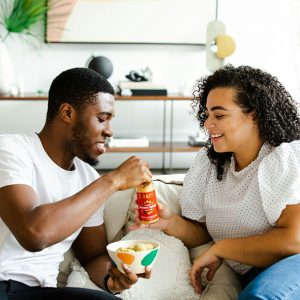Public displays of affection, or PDA, can be a hotly contested issue in relationships. It can bring up feelings of low self-worth, of being unattractive or unlovable. Particularly when we’re not getting the PDA we want, or we’re being pushed to give more than we’re comfortable with, it’s an issue that can feel deeply divisive.
Instead of thinking of a conversation about PDA as a chore or compromise, consider it a great opportunity to learn more about your own and your partner’s basic values and feelings about sex, love, and attraction. Here’s How:
Don’t talk about public displays of affection in public
If you’re in a relationship with someone who never wants to talk about anything these aren’t the tips for you. But if you’ve got a willing partner, timing can make the difference between a productive and exciting conversation and one that goes nowhere fast. The time to talk about public displays of affection is definitely not when you’re in public and trying to get your partner to do something or stop doing something. Pick a time when you’re alone, you’re not rushing around, and you’re both feeling relatively relaxed.
Define PDA for yourselves
You should never start a conversation about sex with any assumptions. So your first step is for each of you to make your own list of all the things you’d consider to be public displays of affection. Things like hand holding and hugging may seem obvious, but what about heavy make out sessions, or things that you do in public that you try to keep hidden? Where’s the line between PDA and sex in public? You can include any activities that you think cross the line just for a reference point.
Sketch out your own lines
Now that you have a list that describes what you consider public displays of affection to include, go down that list (still on your own) and think about what activities you’re comfortable with, which ones you aren’t, and which ones you’re not sure about. For each activity, can you think of times and places where you’d be okay with it and other contexts where you wouldn’t? Note that down too. All of this is helpful in sketching out your own feelings and boundaries, which will help when you start talking to your partner about theirs.
Trade notes
You can decide to just give each other the lists you’ve written out, or make time to share your notes verbally, taking turns talking about what you think does and doesn’t count as PDA, and when you’re okay with it or not. As you do this DO NOT start debating or arguing about what your partner has written down (even if you think they aren’t being “honest”). Being able to listen without attacking is key to good sexual communication so now is the time to describe and listen, not debate.
Acknowledge the public part of PDA
What makes PDA so problematic for some is the public part of them. Whether you like it or not, when you’re in public other people will pay attention to what you do and interpret it in one way or another. Being affectionate in public as long as you show basic consideration for others, is perfectly reasonable. But it still opens up the possibility of public responses that you or your partner may not want to deal with. That alone isn’t a reason not to do it, but if either of you decide you don’t want to deal with a public response, then it becomes a reason.
Explain (don’t defend) yourself
Ideally, if you want something different from your partner, you should be able to tell them why. For example, try and finish this sentence: “The reason I want to be able to be affectionate with you in public is…” This isn’t the same thing as defending what you want (which you shouldn’t have to do in a loving relationship). But if you’re asking your partner to change their behavior, it’s reasonable for them to expect to understand why. Also, explaining why may help them change their behavior.
Listen and look for compromises
If your partner is stuck on the issue and feels like they can’t be more (or less, as the case may be) affectionate in public, go back to the exercise where you made your lists about what’s okay and what isn’t. Were there any examples of PDA they were okay with? If so, can they offer to do more of that? And were there any examples of times or contexts when they’d be okay with PDA that you don’t usually find yourself in? Perhaps you can create more times when they’re in a context that’s comfortable for them, which would give you more PDA.












